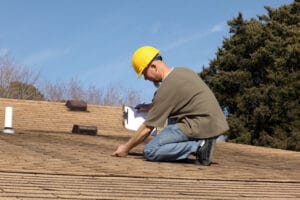How To Determine Roof Pitch
Determining the roof pitch of your home is important in a number of ways. The angle of your roof can impact everything from the amount of snow and ice that builds up on it to how much sunlight it receives. It can also affect the appearance of your home and the type of shingles you can use. In this blog post, we’ll show you how to determine roof pitch so you can make informed decisions about its maintenance and care. Keep reading to learn more!
What is roof pitch and why is it important to know?
Understanding roof pitch is incredibly important for anyone who will be working with a roof. Roof pitch measures the slope of a roof and is expressed as a ratio of the total rise of the roof over its total span. This information helps map out how much installation material and surface material will be needed in order to properly lay the roof, as well as estimating appropriate levels of drainage since steeper roofs require more underlayment and flashing. In addition, different types of material can only be laid at certain kinds of slopes which further drives the need to know precise measurements of your roof’s angle. Ultimately, understanding and accurately measuring your home’s roof pitch will give you a better idea of both the amount and type of materials you need to properly construct your desired design.
How to measure roof pitch using a level
Measuring the pitch of a roof requires an understanding of geometry and a reliable level tool. Start by placing the level on a flat section of the roof, making sure it is completely horizontal. Then, measure the distance from the level to the peak of the roof and record your results. By subtracting this value from 12 inches, you can calculate the rise over distance—the number that reveals the pitch or slope angle of your roof in relation to any given run. This measurement is essential for determining if a standard shingle system is appropriate for your re-roofing project. Ensure your measurements are accurate for effective results.
How to measure roof pitch using a tape measure
Measuring the pitch of a roof can be done quickly and accurately using a regular measuring tape. To start, measure from the peak of the roof to one end of the eave. Then, move back several feet from that same side and measure from the edge down to the same eave. Finally, divide this distance by the original measurement and multiply by 12. This will give you the pitch – expressed as a ratio – in a matter of minutes! Furthermore, utilizing a reference point such as an adjacent wall or chimney for comparison can help confirm accuracy if an exact measurement is required. With just a few simple steps and supplies you can measure roof pitch like a pro.
What are the different types of roofs and their corresponding pitches?
There are a variety of types of roofs and their corresponding slopes, or pitches as they are also known. Some of the most popular types of roof frameworks include gable, hipped, mansard, gambrel, flat, and shed.
Gable roofs involve two sloping sides that meet at the top to form a double-sloped roof peak. The pitch of this type of roof can vary from steep to moderate depending on the preference.
Hipped roofs have four sides that all join at the top with slope differences for each side. Depending on what look is desired for the roofline, the pitch can be steep or shallow but typically lands on the moderate end.
Mansard roofs involve two slopes on either side that meet at a ridge line near the top; these types of roofs normally have more dramatic styles with sharp angles and dramatic changes in pitch which can help provide additional space within the home if desired.
Gambrel roofs are often found on barns and feature a symmetrical steep lower slope with a shallow upper slope to maximize available storage space under the eaves.
Flat roofs are self-explanatory featuring no angle or pitch while shed roofs have one angled face similar to gable rooftops without any multifaceted details like hipped or gambrel designs offer.
How does roof pitch affect the cost of a new roof installation or repair job?
The pitch of a roof can have a significant impact on the cost of a new roof installation or repair job. Generally, roofs with higher pitches are more difficult to work on, as they require extra safety precautions and specialized tools to access. Moreover, these jobs also tend to require additional materials due to the increased surface area. On the other hand, roofs with lower pitches are usually less expensive since they may not need scaffolding and ladders for professional installation or repair. As such, it is important for homeowners considering these projects to carefully consider their roof’s pitch beforehand in order to accurately budget for the job.
Conclusion
In conclusion, it’s important to know the roof pitch of your home because it affects both the cost and feasibility of repair or replacement. Different types of roofs have different ideal pitches, so it’s important to consult with a professional before making any changes. Measuring roof pitch is easy to do with a level or tape measure, and doesn’t require any special tools or expertise. If you have any questions about your roof pitch or need assistance measuring it, don’t hesitate to contact us today. We’ll be happy to answer your questions and schedule a consultation at your earliest convenience. You can also checkout our Google My Business here.
Areas we service include:
- Ladner Roofing
- Roofing Surrey
- Roofing Vancouver
- Roofing North Vancouver
- Roofing Tsawwassen





